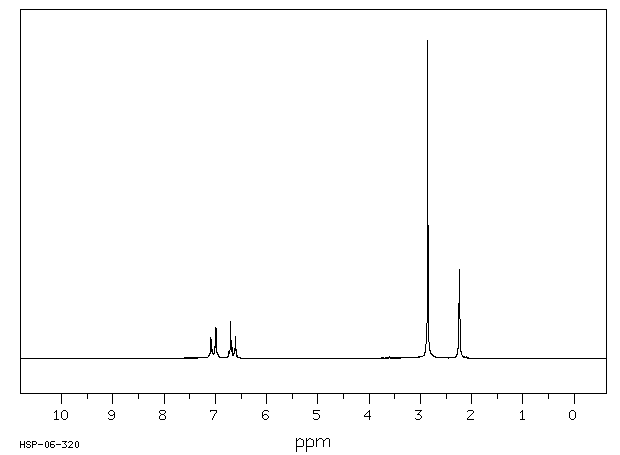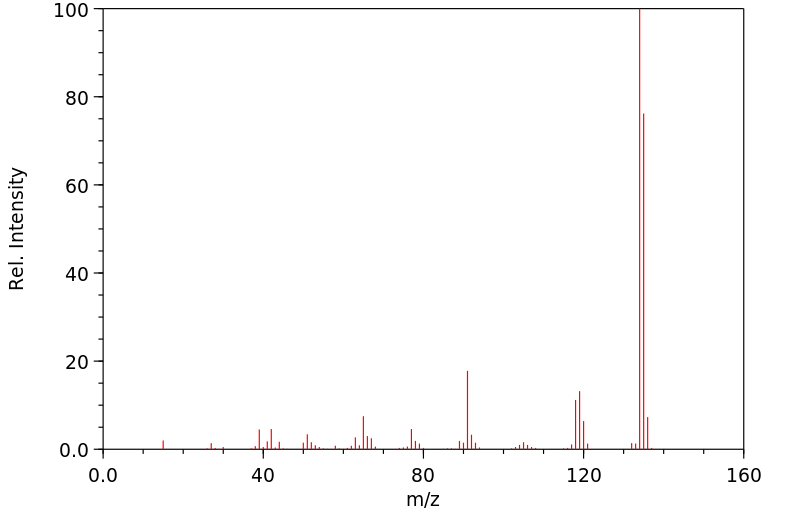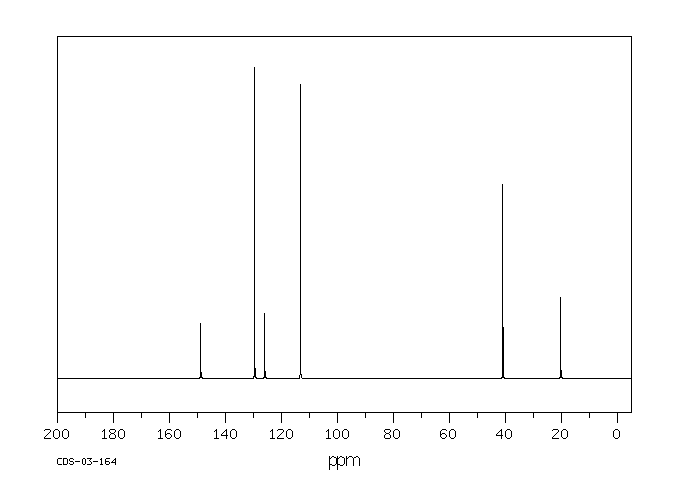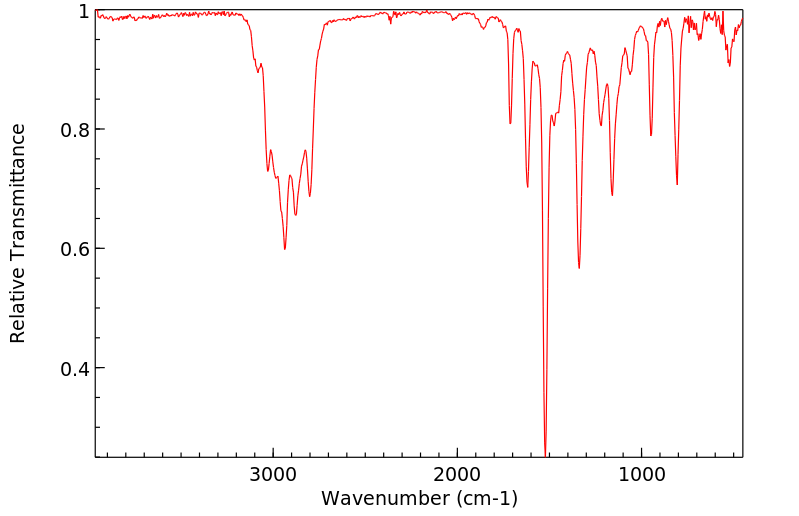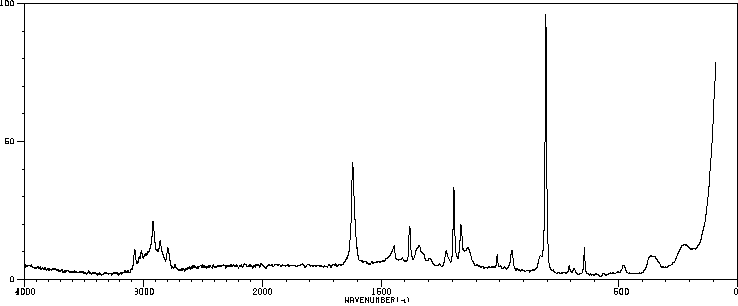N,N-二甲基对甲苯胺 | 99-97-8
-
物化性质
-
计算性质
-
ADMET
-
安全信息
-
SDS
-
制备方法与用途
-
上下游信息
-
文献信息
-
表征谱图
-
同类化合物
-
相关功能分类
-
相关结构分类
物化性质
-
熔点:-25°C
-
沸点:211 °C(lit.)
-
密度:0.937 g/mL at 25 °C(lit.)
-
蒸气密度:>1 (vs air)
-
闪点:182 °F
-
溶解度:水中的溶解度0.65克/升
-
介电常数:3.3(20℃)
-
LogP:1.729-2.81 at 35℃
-
物理描述:N,n-dimethyl-p-toluidine appears as a clear colorless liquid with an aromatic odor. Density 0.937 g / cm3 (Lancaster) and insoluble in water. Hence floats on water. Toxic by skin absorption and inhalation. May release toxic vapors when burned.
-
颜色/状态:Clear colorless liquid
-
气味:Aromatic
-
蒸汽密度:Relative vapor density (air = 1): 4.7
-
蒸汽压力:0.178 mm Hg at 25 °C
-
稳定性/保质期:
避免与强氧化剂、酸、酸酐、酸性氯化物接触。
-
分解:When heated to decomposition ir emits toxic vapors of NOx
-
折光率:Index of refraction: 1.5366 at 20 °C/D
-
解离常数:pKa = 5.63 at 25 °C (conjugate acid)
-
保留指数:1160.4;1162;1163
计算性质
-
辛醇/水分配系数(LogP):2.8
-
重原子数:10
-
可旋转键数:1
-
环数:1.0
-
sp3杂化的碳原子比例:0.333
-
拓扑面积:3.2
-
氢给体数:0
-
氢受体数:1
ADMET
安全信息
-
TSCA:Yes
-
危险等级:6.1
-
危险品标志:T
-
安全说明:S28,S36/37,S45,S61
-
危险类别码:R23/24/25,R52/53,R33
-
WGK Germany:3
-
海关编码:2921430090
-
危险品运输编号:1708
-
危险类别:6.1
-
RTECS号:XU5803000
-
包装等级:II
-
危险性防范说明:P280,P301+P310
-
危险性描述:H227,H301+H311+H331,H373,H412,H350,H360
-
储存条件:储存于阴凉、通风的库房,远离火种、热源,保持容器密封。应与氧化剂、酸性物质、酸酐、酸性氯化物及食用化学品分开存放,切忌混储。配备相应品种和数量的消防器材,并在储区备有合适的材料以收容泄漏物。
SDS
模块1. 化学品
1.1 产品标识符
: 4,N,N-三甲基苯胺
产品名称
1.2 鉴别的其他方法
4-Dimethylaminotoluene
1.3 有关的确定了的物质或混合物的用途和建议不适合的用途
仅用于研发。不作为药品、家庭或其它用途。
模块2. 危险性概述
上述信息视为正确,但不包含所有的信息,仅作为指引使用。本文件中的信息是基于我们目前所知,就正
确的安全提示来说适用于本品。该信息不代表对此产品性质的保证。
参见发票或包装条的反面。
2.1 GHS-分类
易燃液体 (类别 4)
急性毒性, 经口 (类别 3)
急性毒性, 吸入 (类别 3)
急性毒性, 经皮 (类别 3)
特异性靶器官系统毒性(反复接触) (类别 2)
急性水生毒性 (类别 3)
慢性水生毒性 (类别 3)
2.2 GHS 标记要素,包括预防性的陈述
象形图
警示词危险
危险申明
H227可燃液体
H301 + H311 + H331如果咽下,与皮肤接触或吸入是有毒的。
H373长期或重复接触可能会对器官造成伤害。
H412对水生生物有害并有长期持续的影响。
警告申明
预防措施
P210远离热源、火花、明火和热表面。- 禁止吸烟。
P260不要吸入粉尘/ 烟/ 气体/ 烟雾/ 蒸汽/ 喷雾。
P264操作后彻底清洁皮肤。
P270使用本产品时不要进食、饮水或吸烟。
P271只能在室外或通风良好之处使用。
P273避免释放到环境中。
P280穿戴防护手套/ 眼保护罩/ 面部保护罩。
事故响应
P301 + P310如果吞下去了: 立即呼救解毒中心或医生。
P302 + P352如接触皮肤:使用大量水冲洗。
P304 + P340如果吸入:将受害人移至空气新鲜处并保持呼吸舒适的姿势休息。
P314如感觉不适,须求医/ 就诊。
P321具体处置(见本标签上提供的急救指导)。
P330漱口。
P361 + P364立即除去∕脱掉所有沾污的衣物,清洗后方可再用。
P370 + P378在发生火灾时:用干砂,干粉或抗溶性泡沫扑灭。
安全储存
P403 + P233存放于通风良的地方。 保持容器密闭。
P403 + P235保持低温,存放于通风良好处。
P405存放处须加锁。
废弃处置
P501将内容物/ 容器处理到得到批准的废物处理厂。
2.3 其它危害物 - 无
模块3. 成分/组成信息
3.1 物 质
: 4-Dimethylaminotoluene
别名
N,N-Dimethyl-p-toluidine
: C9H13N
分子式
: 135.21 g/mol
分子量
组分浓度或浓度范围
N,N-Dimethyl-p-toluidine
<=100%
化学文摘登记号(CAS99-97-8
No.)202-805-4
EC-编号612-056-00-9
索引编号
模块4. 急救措施
4.1 必要的急救措施描述
一般的建议
请教医生。 向到现场的医生出示此安全技术说明书。
吸入
如果吸入,请将患者移到新鲜空气处。 如呼吸停止,进行人工呼吸。 请教医生。
皮肤接触
用肥皂和大量的水冲洗。 立即将患者送往医院。 请教医生。
眼睛接触
用水冲洗眼睛作为预防措施。
食入
禁止催吐。 切勿给失去知觉者通过口喂任何东西。 用水漱口。 请教医生。
4.2 主要症状和影响,急性和迟发效应
人体吸入引起高铁血红蛋白形成,一定浓度后引起苍白病。一般2~4小时或更长时间后发作,
据我们所知,此化学,物理和毒性性质尚未经完整的研究。
4.3 及时的医疗处理和所需的特殊处理的说明和指示
无数据资料
模块5. 消防措施
5.1 灭火介质
灭火方法及灭火剂
用水雾,抗乙醇泡沫,干粉或二氧化碳灭火。
5.2 源于此物质或混合物的特别的危害
碳氧化物, 氮氧化物
5.3 给消防员的建议
如必要的话,戴自给式呼吸器去救火。
5.4 进一步信息
用水喷雾冷却未打开的容器。
模块6. 泄露应急处理
6.1 作业人员防护措施、防护装备和应急处置程序
戴呼吸罩。 避免吸入蒸气、烟雾或气体。 保证充分的通风。 移去所有火源。 人员疏散到安全区域。
谨防蒸气积累达到可爆炸的浓度。蒸气能在低洼处积聚。
6.2 环境保护措施
如能确保安全,可采取措施防止进一步的泄漏或溢出。 不要让产品进入下水道。
一定要避免排放到周围环境中。
6.3 泄漏化学品的收容、清除方法及所使用的处置材料
围堵溢出,用防电真空清洁器或湿刷子将溢出物收集起来,并放置到容器中去,根据当地规定处理(见第13部
分)。 放入合适的封闭的容器中待处理。
6.4 参考其他部分
丢弃处理请参阅第13节。
模块7. 操作处置与储存
7.1 安全操作的注意事项
避免接触皮肤和眼睛。 避免吸入蒸气和烟雾。
切勿靠近火源。-严禁烟火。采取措施防止静电积聚。
7.2 安全储存的条件,包括任何不兼容性
贮存在阴凉处。 使容器保持密闭,储存在干燥通风处。
打开了的容器必须仔细重新封口并保持竖放位置以防止泄漏。
对光线敏感 充气保存 对空气敏感。
7.3 特定用途
无数据资料
模块8. 接触控制和个体防护
8.1 容许浓度
最高容许浓度
8.2 暴露控制
适当的技术控制
避免与皮肤、眼睛和衣服接触。 休息前和操作本品后立即洗手。
个体防护设备
眼/面保护
面罩與安全眼鏡请使用经官方标准如NIOSH (美国) 或 EN 166(欧盟) 检测与批准的设备防护眼部。
皮肤保护
戴手套取 手套在使用前必须受检查。
请使用合适的方法脱除手套(不要接触手套外部表面),避免任何皮肤部位接触此产品.
使用后请将被污染过的手套根据相关法律法规和有效的实验室规章程序谨慎处理. 请清洗并吹干双手
所选择的保护手套必须符合EU的89/686/EEC规定和从它衍生出来的EN 376标准。
完全接触
物料: 丁基橡胶
最小的层厚度 0.3 mm
溶剂渗透时间: 480 min
测试过的物质ButojECt® (KCL 897 / Z677647, 规格 M)
飞溅保护
物料: 丁腈橡胶
最小的层厚度 0.2 mm
溶剂渗透时间: 30 min
测试过的物质Dermatril® P (KCL 743 / Z677388, 规格 M)
, 测试方法 EN374
如果以溶剂形式应用或与其它物质混合应用,或在不同于EN
374规定的条件下应用,请与EC批准的手套的供应商联系。
这个推荐只是建议性的,并且务必让熟悉我们客户计划使用的特定情况的工业卫生学专家评估确认才可.
这不应该解释为在提供对任何特定使用情况方法的批准.
身体保护
全套防化学试剂工作服, 防护设备的类型必须根据特定工作场所中的危险物的浓度和数量来选择。
呼吸系统防护
如危险性评测显示需要使用空气净化的防毒面具,请使用全面罩式多功能防毒面具(US)或ABEK型
(EN
14387)防毒面具筒作为工程控制的候补。如果防毒面具是保护的唯一方式,则使用全面罩式送风防
毒面具。 呼吸器使用经过测试并通过政府标准如NIOSH(US)或CEN(EU)的呼吸器和零件。
模块9. 理化特性
9.1 基本的理化特性的信息
a) 外观与性状
形状: 透明, 液体
颜色: 黄色
b) 气味
无数据资料
c) 气味阈值
无数据资料
d) pH值
无数据资料
e) 熔点/凝固点
无数据资料
f) 沸点、初沸点和沸程
211 °C90 - 92 °C 在 13 hPa
g) 闪点
76 °C - 闭杯
h) 蒸发速率
无数据资料
i) 易燃性(固体,气体)
无数据资料
j) 高的/低的燃烧性或爆炸性限度 爆炸上限: 7 %(V)
爆炸下限: 1.2 %(V)
k) 蒸气压
0.100 hPa
l) 蒸汽密度
5.42
m) 密度/相对密度
0.937 g/mL 在 25 °C
n) 水溶性
不溶
o) n-辛醇/水分配系数
无数据资料
p) 自燃温度
无数据资料
q) 分解温度
无数据资料
r) 粘度
无数据资料
模块10. 稳定性和反应活性
10.1 反应性
无数据资料
10.2 稳定性
无数据资料
10.3 危险反应
无数据资料
10.4 应避免的条件
热,火焰和火花。
10.5 不相容的物质
酸, 酰基氯, 酸酐, 强氧化剂
10.6 危险的分解产物
其它分解产物 - 无数据资料
模块11. 毒理学资料
11.1 毒理学影响的信息
急性毒性
无数据资料
吸入: 无数据资料
经皮: 无数据资料
半数致死剂量 (LD50) 腹膜内的 - 小鼠 - 212 mg/kg
皮肤刺激或腐蚀
无数据资料
眼睛刺激或腐蚀
无数据资料
呼吸道或皮肤过敏
无数据资料
生殖细胞致突变性
细胞突变性-体内试验 - 大鼠 - 腹膜内的
DNA损伤
细胞突变性-体内试验 - 小鼠 - 腹膜内的
DNA损伤
致癌性
IARC:
此产品中没有大于或等于 0。1%含量的组分被 IARC鉴别为可能的或肯定的人类致癌物。
生殖毒性
无数据资料
特异性靶器官系统毒性(一次接触)
无数据资料
特异性靶器官系统毒性(反复接触)
长期或重复接触可能会对器官造成伤害。
吸入危险
无数据资料
潜在的健康影响
吸入吸入会中毒。 可能引起呼吸道刺激。
摄入误吞会中毒。
皮肤如果被皮肤吸收会有毒性 可能引起皮肤刺激。
眼睛可能引起眼睛刺激。
接触后的征兆和症状
人体吸入引起高铁血红蛋白形成,一定浓度后引起苍白病。一般2~4小时或更长时间后发作,
据我们所知,此化学,物理和毒性性质尚未经完整的研究。
附加说明
化学物质毒性作用登记: XU5803000
模块12. 生态学资料
12.1 生态毒性
对鱼类的毒性半数致死浓度(LC50) - 肥头鲦鱼 (黑头软口鲦鱼) - 46 - 52 mg/l - 96.0 h
12.2 持久性和降解性
无数据资料
12.3 潜在的生物累积性
无数据资料
12.4 土壤中的迁移性
无数据资料
12.5 PBT 和 vPvB的结果评价
无数据资料
12.6 其它不良影响
对水生生物有害并有长期持续的影响。
模块13. 废弃处置
13.1 废物处理方法
产品
此易爆炸产品可以在备有燃烧后处理和洗刷作用的化学焚化炉中燃烧
将剩余的和不可回收的溶液交给有许可证的公司处理。
受污染的容器和包装
按未用产品处置。
模块14. 运输信息
14.1 联合国危险货物编号
欧洲陆运危规: 2810国际海运危规: 2810国际空运危规: 2810
14.2 联合国运输名称
欧洲陆运危规: TOXIC LIQUID, ORGANIC, N.O.S.
国际海运危规: TOXIC LIQUID, ORGANIC, N.O.S.
国际空运危规: Toxic liquid, organic, n.o.s.
14.3 运输危险类别
欧洲陆运危规: 6.1国际海运危规: 6.1国际空运危规: 6.1
14.4 包裹组
欧洲陆运危规: III国际海运危规: III国际空运危规: III
14.5 环境危险
欧洲陆运危规: 否国际海运危规国际空运危规: 否
海洋污染物(是/否): 否
14.6 对使用者的特别提醒
无数据资料
模块 15 - 法规信息
N/A
模块16 - 其他信息
N/A
制备方法与用途
N,N-二甲基对甲苯胺是一种无色或浅黄色油状液体,带有类似臭鸡蛋的气味。其熔点为130.31℃,沸点在211.5至212.5℃之间,常温下的密度范围是0.9287~0.9366g/mL,折光率为1.5360~1.5470。该物质不溶于水,但可溶解于某些有机溶剂,并在光照条件下会分解。
产品描述N,N-二甲基对甲苯胺作为一种有效的光引发剂,用于丙烯腈(AN)聚合;同时也可以用于制备自凝牙托水。
聚合反应芳香叔胺中的N,N-二甲基对甲苯胺作为丙烯腈(AN)聚合的有效光引发剂。介质的极性对聚合速率有很大影响:在极性介质中,聚合速度加快;而氧含量增加会导致聚合诱导期延长,并使聚合速度下降。N,N-二甲基对甲苯胺通常被认为是烯类聚合的缓聚剂而非丙烯腈(AN)光聚合的引发剂。
聚合特征N,N-二甲基对甲苯胺在黑暗中不能引发丙烯腈(AN)的聚合,但在光照条件下,其引发聚合的速度非常快。图1展示了N,N-二甲基对甲苯胺、萘、二苯酮(BP)-三乙胺(TEA)存在下以及ABlN存在的丙烯腈光聚合情况,不同条件下的聚合速率分别为0.157%,0.023%,0.139%和0.045%分一。这表明N,N-二甲基对甲苯胺是丙烯腈(AN)光聚合的有效引发剂。
自由基机制下,N,N-二甲基对甲苯胺引发丙烯腈(AN)的光聚合过程会受到微量自由基捕捉剂的影响而停止。例如,在[N,N-二甲基对甲苯胺]-10^-3M浓度下加入200ppm 2,2,6,6-四甲基哌啶醇氮氧自由基后,光照1.5小时仍无任何聚合发生;而在相同条件下不加自由基捕捉剂时,在光照两分钟后就出现了聚丙烯腈白色沉淀。
应用N,N-二甲基对甲苯胺作为有效的光引发剂用于丙烯腈(AN)聚合,并且其聚合速度与AN浓度的1.62次方和DMT浓度的0.62次方呈正相关。此外,它还被用作促进剂以及不饱和聚酯合成、粘接剂添加剂等。
合成方法N,N-二甲基对甲苯胺可通过硫酸二甲作为甲基化剂,在低温常压条件下进行合成。
用途该物质可用于制备自凝牙托水;此外,它还可以在二叔丁基过氧化物存在的条件下与苯乙炔和苯甲酰胺发生铁催化氧化C-C偶联反应,分别生成N,4-二甲基-N-(3-苯基丙-2-炔基)苯氮胺及N-((甲基(对甲苯基)氨基)甲基)苯甲酰胺。
上下游信息
-
上游原料
中文名称 英文名称 CAS号 化学式 分子量 N-甲基-对甲基苯胺 N-methyl-p-toluidine 623-08-5 C8H11N 121.182 对二甲氨基苯甲醛 4-dimethylamino-benzaldehyde 100-10-7 C9H11NO 149.192 4-(二甲胺基)苄腈 4-cyano-N,N-dimethylaniline 1197-19-9 C9H10N2 146.192 4-(二甲氨基)苄醇 N,N-dimethyl-4-hydroxymethylaniline 1703-46-4 C9H13NO 151.208 N,4'-二甲基甲酰苯胺 N-methyl-N-(4-methylphenyl)formamide 2739-04-0 C9H11NO 149.192 N,N-二乙基对甲苯胺 N,N-diethyl-p-toluidine 613-48-9 C11H17N 163.263 4-甲酰苯胺 N-(4-methylphenyl)formamide 3085-54-9 C8H9NO 135.166 —— 4-N,N-dimethylaminobenzaldehyde hydrazone 41463-93-8 C9H13N3 163.222 N,N-二甲基苯胺 N,N-dimethyl-aniline 86362-18-7 C8H11N 121.182 N,N,4-三甲基苯胺 N-氧化物 N,N-dimethyl-p-toluidine N-oxide 825-85-4 C9H13NO 151.208 —— N,N-dimethyl-4-((trimethylsilyl)methyl)aniline —— C12H21NSi 207.391 N,N,3,5-四甲基苯胺 3,5,N,N-tetramethylaniline 4913-13-7 C10H15N 149.236 N-(4-二甲氨基苄基)苯胺 N-(4-dimethylaminobenzyl)aniline 3526-44-1 C15H18N2 226.321 4-二甲氨基苯甲酸 p-N,N-dimethylaminobenzoic acid 619-84-1 C9H11NO2 165.192 N,N-二甲基-对苯二胺 4-amino-N,N-dimethylaniline 99-98-9 C8H12N2 136.197 乙烷,三氯氟- p-toluidine 106-49-0 C7H9N 107.155 —— p-Dimethylaminobenzylalkohol-trimethylsilylether 14629-54-0 C12H21NOSi 223.39 —— p-N,N-dimethylamino-benzyl acetate 20765-67-7 C11H15NO2 193.246 N-(4-二甲氨基苄亚基)苯胺 N,N-dimethyl-4-((phenylimino)methyl)aniline 889-37-2 C15H16N2 224.305 N-甲基甲酰苯胺 N-Methylformanilide 93-61-8 C8H9NO 135.166 4-二甲氨基苯甲酸甲酯 methyl 4-(N,N-dimethylamino)benzoate 1202-25-1 C10H13NO2 179.219 2-溴-N,N,4-三甲基苯胺 2-bromo-N,N,4-trimethylaniline 23667-06-3 C9H12BrN 214.105 —— 3-(4-methylphenyl)-1,5,3-dithiazepane 1376771-28-6 C11H15NS2 225.379 N,N-二乙基苯胺 N,N-diethylaniline 91-66-7 C10H15N 149.236 —— bis-(4-dimethylamino-benzylidene)-p-phenylenediamine 15257-27-9 C24H26N4 370.497 - 1
- 2
- 3
-
下游产品
中文名称 英文名称 CAS号 化学式 分子量 N-甲基-对甲基苯胺 N-methyl-p-toluidine 623-08-5 C8H11N 121.182 对二甲氨基苯甲醛 4-dimethylamino-benzaldehyde 100-10-7 C9H11NO 149.192 N,4'-二甲基甲酰苯胺 N-methyl-N-(4-methylphenyl)formamide 2739-04-0 C9H11NO 149.192 N,N-二乙基对甲苯胺 N,N-diethyl-p-toluidine 613-48-9 C11H17N 163.263 4-甲酰苯胺 N-(4-methylphenyl)formamide 3085-54-9 C8H9NO 135.166 —— 4-dimethylaminobenzaldehyde oxime —— C9H12N2O 164.207 2-(甲基(对甲苯)氨基)乙腈 2-[methyl(p-tolyl)amino]acetonitrile 64672-68-0 C10H12N2 160.219 4-[2-[4-(二甲氨基)苯基]乙基]-N,N-二甲基苯胺 N,N,N',N'-tetramethyl-α,α'-bi-p-toluidine 793-08-8 C18H24N2 268.402 N,N-二甲基苯胺 N,N-dimethyl-aniline 86362-18-7 C8H11N 121.182 N,N,4-三甲基苯胺 N-氧化物 N,N-dimethyl-p-toluidine N-oxide 825-85-4 C9H13NO 151.208 —— N-(4-methylphenyl)-N,N-bis(cyanomethyl)amine 46298-13-9 C11H11N3 185.228 N~1~,n~1~,4-三甲基-1,2-苯二胺 2-Dimethylamino-5-methylanilin 183251-82-3 C9H14N2 150.224 —— N-(but-3-enyl)-N,4-dimethylbenzenamine 1227403-23-7 C12H17N 175.274 N,N,2,4-四甲基苯胺 N,N,2,4-tetramethylaniline 769-53-9 C10H15N 149.236 N,N,3,5-四甲基苯胺 3,5,N,N-tetramethylaniline 4913-13-7 C10H15N 149.236 1-(4-甲基苯基)吡咯烷 1-p-tolylpyrrolidine 54104-82-4 C11H15N 161.247 4-二甲氨基苯甲酸 p-N,N-dimethylaminobenzoic acid 619-84-1 C9H11NO2 165.192 乙烷,三氯氟- p-toluidine 106-49-0 C7H9N 107.155 N-甲基-N-(4-甲基苯基)乙酰胺 4-(N-methylacetamido)toluene 612-03-3 C10H13NO 163.219 4-(对甲苯基)吗啉 4-(4-methylphenyl)morpholine 3077-16-5 C11H15NO 177.246 N-(4-叔丁基苯基)-N-甲基甲酰胺 N-(4-(tert-butyl)phenyl)-N-methylformamide 5279-60-7 C12H17NO 191.273 —— 3-chloro-N,N,4-trimethylaniline 75560-65-5 C9H12ClN 169.654 —— N-(4-methylphenyl)piperidine 31053-03-9 C12H17N 175.274 2-(N,N-二甲氨基)-5-甲基苯酚 2-(N,N-dimethylamino)-5-methylphenol 102439-20-3 C9H13NO 151.208 —— 2-chloro-4-methyl-N,N-dimethylaniline 196803-74-4 C9H12ClN 169.654 —— N-[[Methyl(4-methylphenyl)amino]methyl]acetamide 947515-52-8 C11H16N2O 192.261 —— 4-(methyl(p-tolyl)amino)butan-2-one 72371-25-6 C12H17NO 191.273 —— 1-p-tolylazepane 120238-35-9 C13H19N 189.301 —— N-(6-chlorohex-2-ynyl)-N,4-dimethylbenzenamine 1141469-39-7 C14H18ClN 235.757 —— N,4-dimethyl-N-(2-nitroethyl)aniline —— C10H14N2O2 194.233 2-溴-N,N,4-三甲基苯胺 2-bromo-N,N,4-trimethylaniline 23667-06-3 C9H12BrN 214.105 —— N,4-dimethyl-N-(non-2-ynyl)benzenamine 1141469-31-9 C17H25N 243.392 N,N-二乙基苯胺 N,N-diethylaniline 91-66-7 C10H15N 149.236 4-乙基苯胺 4-aminoethylbenzene 589-16-2 C8H11N 121.182 N-苄基-N,4-二甲基苯胺 N-benzyl-N-methyl-4-methylaniline 69267-39-6 C15H17N 211.307 —— N-methyl-N-nitroso-p-toluidine 937-24-6 C8H10N2O 150.18 4-甲氨基苯甲酸 4-methylaminobenzoic acid 10541-83-0 C8H9NO2 151.165 —— N,4-dimethyl-N-phenylaniline 38158-65-5 C14H15N 197.28 - 1
- 2
- 3
- 4
反应信息
-
作为反应物:描述:参考文献:名称:NH4I/叔丁基氢过氧化物促进叔胺的氧化 C-N 裂解导致硝基芳族化合物摘要:已开发出 NH4I/叔丁基氢过氧化物促进叔 N-芳基-N,N-二烷基胺在 DMSO 中的氧化,以获取硝基芳族化合物。该方法涉及一锅法中的连续 N-脱烷基化反应,并提出了自由基途径。DOI:10.3184/174751917x15022797727991
-
作为产物:描述:参考文献:名称:硼酸催化酯、羧酸和氨基甲酸酯彻底还原为甲基摘要:新型无金属催化剂体系简化了有机合成中常用的羧基到甲基的多步还原。它使用硼酸催化酯、羧酸和氨基甲酸酯一步还原为甲基。使用氨硼烷作为氢供体在温和条件下实现高产率、多功能产物的形成。DOI:10.1002/ejoc.202300904
-
作为试剂:描述:参考文献:名称:Cymerman-Craig et al., Australian Journal of Chemistry, 1956, vol. 9, p. 222,226摘要:DOI:
文献信息
-
Compositions for Treatment of Cystic Fibrosis and Other Chronic Diseases申请人:Vertex Pharmaceuticals Incorporated公开号:US20150231142A1公开(公告)日:2015-08-20The present invention relates to pharmaceutical compositions comprising an inhibitor of epithelial sodium channel activity in combination with at least one ABC Transporter modulator compound of Formula A, Formula B, Formula C, or Formula D. The invention also relates to pharmaceutical formulations thereof, and to methods of using such compositions in the treatment of CFTR mediated diseases, particularly cystic fibrosis using the pharmaceutical combination compositions.
-
H<sub>5</sub>IO<sub>6</sub>/KI: A New Combination Reagent for Iodination of Aromatic Amines, and Trimethylsilylation of Alcohols and Phenols through<i>in situ</i>Generation of Iodine under Mild Conditions作者:Mohammad Ali Zolfigol、Ardeshir Khazaei、Eskandar Kolvari、Nadiya Koukabi、Hamid Soltani、Maryam BehjuniaDOI:10.1002/hlca.200900259日期:2010.3A simple method for the in situ generation of iodine using H5IO6/KI has been developed, and its application in silylation of OH group and iodination of aromatic amines is described.
-
{[K.18-Crown-6]Br3}n: a unique tribromide-type and columnar nanotube-like structure for the oxidative coupling of thiols and bromination of some aromatic compounds作者:Mohammad Ali Zolfigol、Gholamabbas Chehardoli、Sadegh Salehzadeh、Harry Adams、Michael D. WardDOI:10.1016/j.tetlet.2007.09.050日期:2007.11Reaction of 18-crown-6 with KBr and then with bromine (Br2) afforded a unique tribromide salt with a nanotube-like structure ([K.18-crown-6]Br3}n). Oxidative coupling of thiols and bromination of some aromatic compounds is the first report on the chemistry of this reagent.
-
SILANE COUPLING COMPOUNDS AND MEDICAL AND/OR DENTAL CURABLE COMPOSITIONS COMPRISING THE SAME申请人:KABUSHIKI KAISHA SHOFU公开号:US20190300552A1公开(公告)日:2019-10-03The present invention relate to a novel silane coupling agent and a medical and/or dental curable composition comprising the same. It is an object of the present invention to provide a novel silane coupling agent that imparts high affinity to a radical polymerizable monomer, thereby imparting high mechanical strength, flexibility and durability when used for a medical and/or dental curable composition, and an inorganic filler surface-treated with the novel silane coupling agent and a novel medical and/or dental curable composition. A silane coupling agent including repeating units such as a urethane bond and polyethylene glycol (ether bond) at a specific position is used.
-
Main-Group-Catalyzed Reductive Alkylation of Multiply Substituted Amines with Aldehydes Using H<sub>2</sub>作者:Yoichi Hoshimoto、Takuya Kinoshita、Sunit Hazra、Masato Ohashi、Sensuke OgoshiDOI:10.1021/jacs.8b03626日期:2018.6.13the growing demand for green and sustainable chemical processes, the catalytic reductive alkylation of amines with main-group catalysts of low toxicity and molecular hydrogen as the reductant would be an ideal method to functionalize amines. However, such a process remains challenging. Herein, a novel reductive alkylation system using H2 is presented, which proceeds via a tandem reaction that involves鉴于对绿色和可持续化学过程的需求不断增长,以低毒主族催化剂和分子氢为还原剂的胺的催化还原烷基化将是一种理想的胺官能化方法。然而,这样的过程仍然具有挑战性。在此,提出了一种使用 H2 的新型还原性烷基化系统,该系统通过串联反应进行,该反应涉及 B(2,6-Cl2C6H3)(p-HC6F4)2 催化形成亚胺,随后通过沮丧的刘易斯对(FLP)。这种还原性烷基化反应产生 H2O 作为唯一的副产物,并直接将带有广泛取代基的胺官能化,这些取代基包括羧基、羟基、附加氨基、伯酰胺和伯磺酰胺基团。异吲哚啉酮和氨基邻苯二甲酸酐的合成也已通过一锅法实现,该法分别由本发明的还原烷基化与分子内酰胺化和分子内脱水反应的组合组成。该反应分别显示出对亚胺中间体和 B(2,6-Cl2C6H3)(p-HC6F4)2 浓度的零级和一级依赖性。此外,H2 浓度显着影响反应进程。这些结果表明了一种可能的机制,其中包含 THF 和 B(2
表征谱图
-
氢谱1HNMR
-
质谱MS
-
碳谱13CNMR
-
红外IR
-
拉曼Raman
-
峰位数据
-
峰位匹配
-
表征信息


